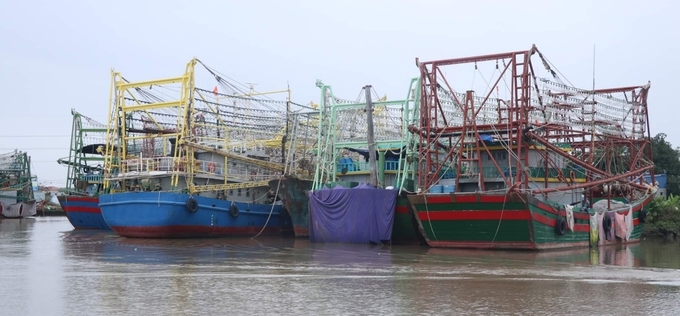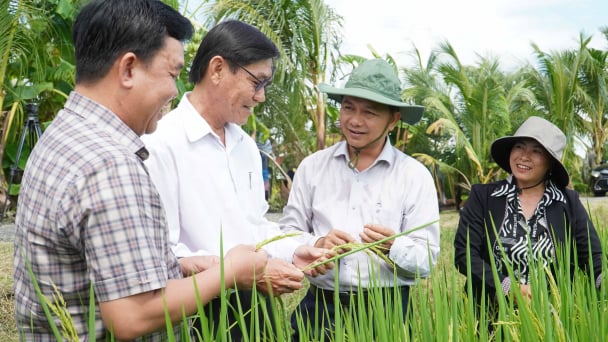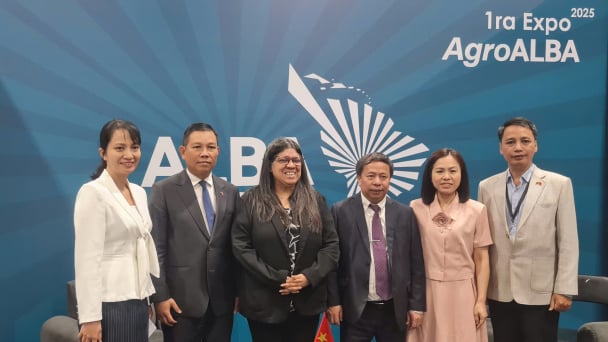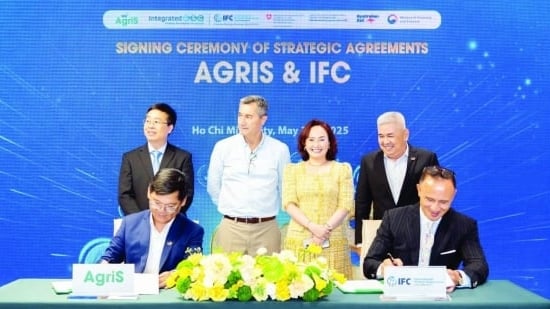June 21, 2025 | 02:39 GMT +7
June 21, 2025 | 02:39 GMT +7
Hotline: 0913.378.918
June 21, 2025 | 02:39 GMT +7
Hotline: 0913.378.918

Hai Phong is a locality with a large number of offshore fishing vessels. To date, almost all ships use LED lights. Photo: Dinh Muoi.
As one of the four most significant fishing grounds in the nation, Hai Phong is home to a vast number of fishing vessels, including 357 15-meter-height offshore fishing vessels. In the past, almost all ships utilized Siu lights, also known as high-pressure lights, with a capacity of 1,000 to 1,500 W per light bulb.
To attract fish and crustaceans, each fishing vessel must be outfitted with an average of 50 to 450 lights; however, a large number of lights also results in high costs. This is a significant amount of burden imposed on fishermen prior to each voyage to sea.
Not only does it consume fuel, but the installation cost of this type of lamp is also very high due to its extremely brief longevity and unstable generator current when used continuously in a highly saline seawater environment meanwhile actual duration of use is only 4 to 6 months.
The situation has improved since the construction of a new ship with a capacity of 829 CV and the installation of LED lighting. Using LED lighting has helped his family save motor oil, reduce costs for each journey to the shore, increase exploitation efficiency, and capture environmentally friendly aquatic products.
Dr. Nguyen Phu Toan of the Institute of Seafood Research, who has participated in research in this field, stated that after obtaining the research results, the solution has been implemented on numerous vessels across the nation.
Traditional lamps with a maximum wattage of 1,200W consume a significant amount of energy and fuel. This disadvantage causes high production costs and low economic value for fishermen.
LED technology can save up to 80%. This also reduces energy consumption by five to six times, allowing fishermen to remain at sea longer and increasing the economic value of each voyage.
While conventional high-pressure lamps do not utilize reflectors, they are only able to concentrate fish in the water's surface layer in terms of their efficacy in capturing and harvesting seafood. Reflectors are utilized by LED lights to assure optical directionality on both the surface and deeper strata of water.
In addition, the light emitted by this type of lamp does not frighten fish, makes it easier to see fish underwater, and improves the ability to differentiate between various types of fish and many aquatic products. The use of LED lighting in offshore fishing makes exploitation and fishing more productive than in the past.

For fish sailing, lighting equipment is one of the very important factors. Photo: Dinh Muoi.
The absence of toxic compounds from LED lighting ensures the safety of the aquatic environment. At the same time, modern structures contribute to the reduction of CO2 and air emissions, ensuring the purity of the environment, particularly the air and water.
Modern LED fishing lights do not emanate ultraviolet (UV) or infrared (IR) rays, protecting the epidermis and ensuring the safety of crew members who frequently work under the lights. This technology is extremely secure for users, whereas traditional lamps emit a great deal of heat and emit UV radiation that are detrimental to health, causing skin burns, dry skin, hair loss, and even cancer.
According to Dr. Toan, the average cost of a sea voyage for fishing nets using LED lights is only approximately 66.95% of that of ships using traditional lights; therefore, the average profit of a sea voyage for fishing nets using LED lights is 1.73 times that of ships with traditional lights. This is a cost-saving profit from the generator and enhanced fishing output on preserves during the voyage.
Regarding initial investment, the capital source for a lighting system containing 250 LED bulbs with a capacity of 200 W/bulb is only approximately 50.8% of the initial investment cost for a lighting system containing 250 high-pressure bulbs with a capacity of 1,000 W/bulb.
Taking into account only the savings on generator oil and repair and replacement costs, the ROI for LED bulbs is 7.67% per month. The capital recovery period is approximately 13.03 months.

Seafood exploitation efficiency is better when fishermen use LED lights. Photo: Dinh Muoi.
According to current statistics, there are approximately 2,776 fishing vessels in the United States, of which 2,264 are engaged in offshore fishing. In fact, many fishing nets from provinces such as Quang Ninh, Hai Phong, Thanh Hoa, Nghe An, Quang Binh, Quang Nam, and Binh Thuan have successfully implemented LED lighting for production.
The Seafood Research Institute has selected provinces/cities such as Quang Ninh, Hai Phong, Thanh Hoa, Nghe An, Quang Binh, Quang Tri, Binh Dinh, and Binh Thuan to implement LED lighting solutions in production practices, based on the outlines of research projects approved by the Ministry of Agriculture and Rural Development.

A bountiful sea trip for fishermen at Bach Long Vy fishing grounds. Photo: Dinh Muoi.
In transmitting technology to the fishery community, the unit has coordinated closely with the Department of Fisheries, the Center for Agricultural Extension, and the Department of Agriculture and Rural Development of the transfer districts. In addition, the Institute has collaborated with businesses to provide equipment, technical assistance, training, and communication throughout the transfer procedure.
Translated by Linh Linh
/2025/06/17/3942-2-143243_548.jpg)
(VAN) Recently, in Sweden, the Secretary of the Binh Dinh Provincial Party Committee presented the Investment Registration Certificate for the 'Polyester Fabric Recycling Complex' project to SYRE Impact-AB Company.
/2025/06/12/3721-2-202745_83.jpg)
(VAN) TH made an impression at Seoul Food 2025 with its line of natural beverages, paving the way for Vietnamese food products to enter the South Korean market.

(VAN) Soc Trang's success in rice exports stems from a strategy of developing fragrant and specialty rice cultivation areas and standardizing production toward low-emission practices.
/2025/06/11/1311-5-120811_839.jpg)
(VAN) The pig farming industry is facing the challenge of comprehensive restructuring to meet requirements for quality, safety, traceability, and market expansion both domestically and for export.

(VAN) Vietnam considers participating in ALGROALBA in order to expand agricultural production, coordinate the assessment and effective exploitation potential land.
/2025/06/05/5314-1-184727_407.jpg)
(VAN) From seemingly worthless fish scales and skin, enzymes and lactic ferments can transform by-products into peptides, opening a sustainable, effective business direction and elevating Vietnamese seafood.

(VAN) TTC AgriS and IFC signed a strategic partnership to develop a sustainable agricultural value chain, aiming to achieve the Net Zero target by 2035.